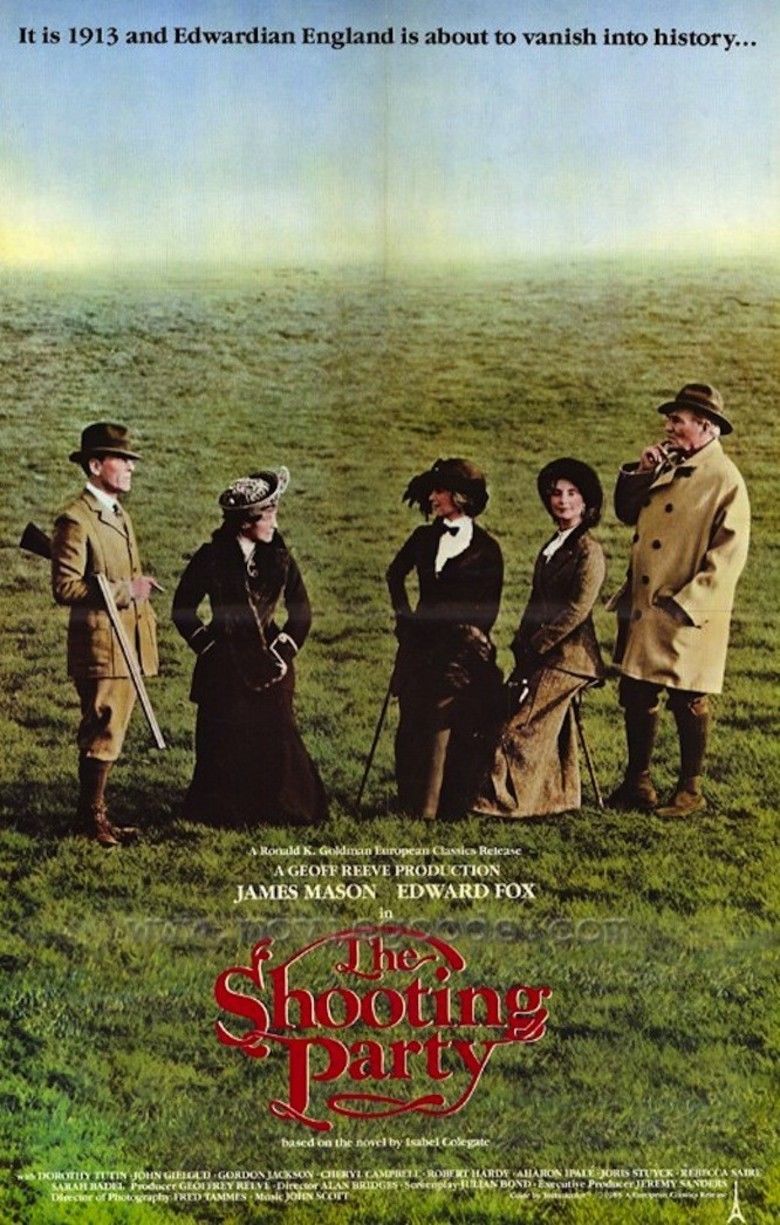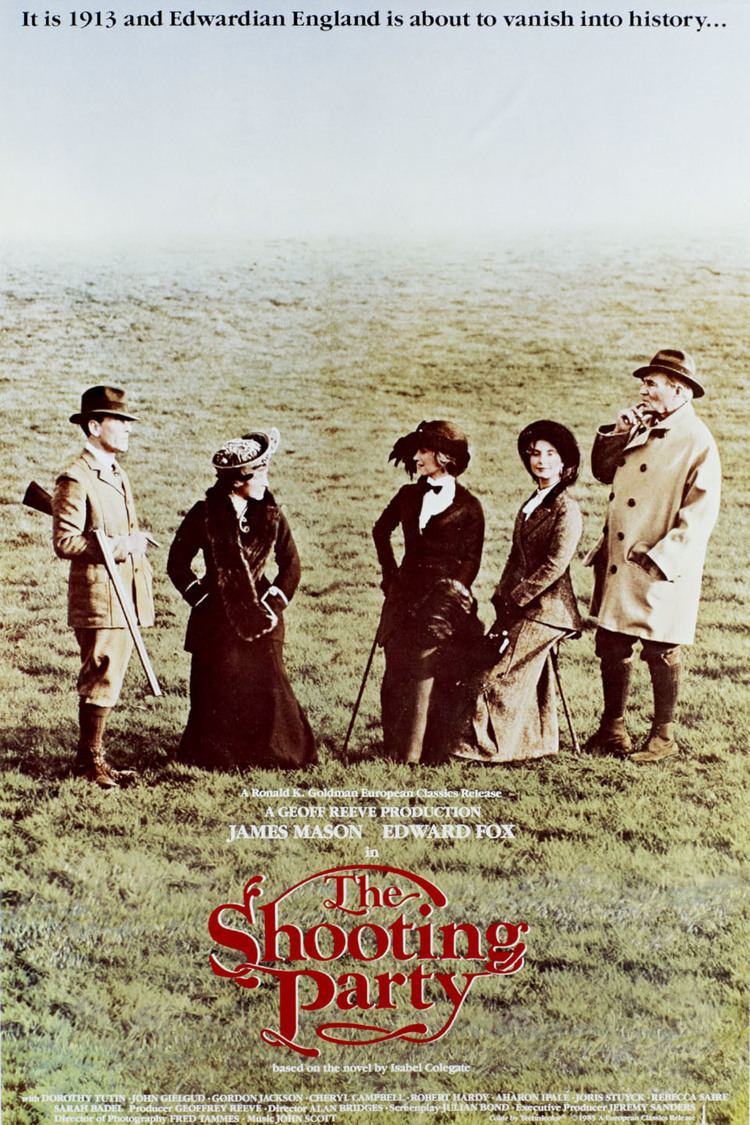The Shooting Party
7.2 /10 1 Votes7.2
3/4 Roger Ebert Genre Drama, Romance Country United Kingdom | 7/10 IMDb Initial DVD release October 17, 2006 Duration Language English | |||||||||||||||||||||||||||||||||
 | ||||||||||||||||||||||||||||||||||
Release date February 1985 (1985-02) Cast (Sir Randolph Nettleby), (Lord Gilbert Hartlip), (Lady Minnie Nettleby), (Cornelius Cardew), (Tom Harker), Similar movies James Mason appears in The Shooting Party and They Were Sisters | ||||||||||||||||||||||||||||||||||
Scene from the shooting party
The Shooting Party is a 1985 British drama film directed by Alan Bridges and based on the book of the same name by Isabel Colegate. The film is set in 1913 and shows the way of life of English aristocrats, gathered for pheasant shooting and general self-indulgence. Their way of life is contrasted with the local rural poor, who serve as 'beaters', driving the game for the aristocrats to shoot. It was entered into the 14th Moscow International Film Festival.
Contents
- Scene from the shooting party
- The shooting party
- Plot summary
- Cast
- Analysis
- Production
- Reception
- References

The shooting party
Plot summary

In the autumn of 1913, a large party of guests gather at the estate of Sir Randolph Nettleby (James Mason) and his wife Minnie (Dorothy Tutin) for a weekend of shooting. Over the next few days two of the guests, Lord Gilbert Hartlip (Edward Fox) and Lionel Stephens (Rupert Frazer), engage in an escalating contest over who can shoot the most game. Hartlip is a renowned sportsman threatened by Frazer's skill, while Frazer is anxious to impress his sweetheart, the married Olivia (Judi Bowker). Hartlip's wife, Aline (Cheryl Campbell) is carrying on an indiscreet love affair with another guest, Sir Reuben Hergesheimer (Aharon Ipalé). Meanwhile, the Nettlebys' granddaughter Cicely (Rebecca Saire) is allowing herself to be courted by a Hungarian count (Joris Stuyck), much to the chagrin of her mother Ida (Sara Badel).
All of the characters' personal tensions reach their breaking-point when one of the party is killed accidentally on the final day of shooting, leading the guests to reconsider their relationships. In the closing scene credits reveal the members of the shooting party who would later be killed in the First World War.
Cast
Analysis
There is a general feeling of the end of a way of life, as the characters go about their lives unaware of the coming war (World War I) and the changes it will bring.
Released posthumously, this is the last film appearance by James Mason, who plays Sir Randolph Nettleby, the local landowner who has something of the old values. Edward Fox as Lord Gilbert Hartlip represents the newer types who don't have the same solid beliefs: he gets into a competition over who is the best shot, despite his host's disapproval.
Production
According to the DVD extras documentary, on the very first shoot of the very first day of filming, all the male lead actors, including Paul Scofield who was playing Sir Randolph Nettleby, were to come into shot on a horse-drawn shooting-brake driven by the well-known film horse-master George Mossman. However as they turned the first corner, the brake-plank that Mossman was standing on broke in two and Mossman was hurled forward and down falling between the sets of wheels, taking the reins with him. He was struck by a horse's hoof and concussed. The horses then shied and broke into a gallop. Rupert Frazer admitted that he was the first to jump off, landing safely, but bruised. Now out of control, the horses turned to the right when confronted by a stone wall causing the shooting-brake to roll completely, catapulting the actors into a pile of scaffolding that had been stacked next to the wall. Robert Hardy stood up and realised to his amazement that he was unhurt. He looked across to see Edward Fox stand up, "turn completely green and collapse in a heap". He had broken five ribs and his shoulder-blade. He then noticed that Paul Scofield was lying very still on the ground, "and I saw that his shin-bone was sticking out through his trousers". As the film takes place in October due to the partridge-shooting season, the filmmakers had to make a choice to either delay filming for a year, or re-cast. James Mason was just finishing filming Doctor Fischer of Geneva for the BBC and the schedule was changed to allow him to take over the part of Sir Randolph Nettleby six weeks later.
Reception
The film was reviewed positively by the critic Pauline Kael. "Bridges [as can be seen also in his 1982 film The Return of the Soldier], has a special gift for these evocations of a world seen in a bell jar, and now, with Geoffrey Reeve as producer and Fred Tammes as cinematographer, he has refined his techniques. A late bloomer (he was born in 1927), Bridges goes beyond being pictorial and literary. He sharpens the novel's wry observations on the Edwardian era and at the same time infuses a sensuous sweetness into the material. On television, a novel like The Shooting Party would be a six-part series, full of longueurs. Here, after we've met the key members of the party, the film puts us among actions and conversations going on simultaneously. And as the events become more intense Bridges picks up the pace and tightens the film's emotional hold on us. Actresses such as Cheryl Campbell and Judi Bowker make a stronger impression in their brief screen time than they do in their much longer stints on TV. Cheryl Campbell is at one moment a pert-faced, nosy gossip, and at the next a tantalising sensualist being caressed by her own long, wavy blond hair. It's a quicksilver performance that recalls Joan Greenwood at her most seductive. And Judi Bowker as the guileless Lady Olivia, the wife of thick-headed Lord Lilburn (Robert Hardy), looks at the camera with a direct gaze that makes her seem infinitely beautiful. When the tall, slim young barrister Lionel Stephens (Rupert Frazer), declares his love for her, you think, Of course – how could he look into her clear eyes and not imagine depths of mystery?"
References
The Shooting Party WikipediaThe Shooting Party IMDbThe Shooting Party Roger EbertThe Shooting Party themoviedb.org
